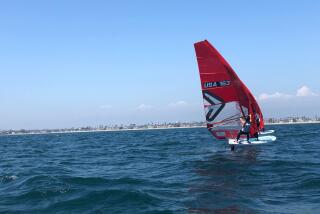Old Concept, New Application
- Share via
Among other things, NASA space physicists such as Paulett Liewer of Jet Propulsion Laboratory get paid to dream. One of their dreams is of a spacecraft that can hoist a cellophane-thin reflective sail larger than four football fields and sail the universe on photons of sunlight. Those photons are pure energy, and in the vacuum of outer space they’re powerful enough to push a sail. Because there’s no friction in outer space to brake that motion, a small spacecraft sailing from near the sun can gather considerable momentum (like a runaway truck going downhill) and leave the solar system at high speed. You can learn more about solar sailing at NASA’s solar sailing Web site (https://interstellar.jpl.nasa.gov).
How did scientists come up with the idea of using photons to power spacecraft?
For physicists, it goes back at least to when Einstein came up with the equivalence of mass and energy (e=mc2). A photon of light acts like a particle. It can push on materials, even though it is pure energy.
But you can barely feel sunlight.
It’s a little push, so the sails are very big.
What happens when you run out of sunlight?
After Jupiter the light intensity is too low--it’s too dark. [The sail would be jettisoned after the spacecraft passes Jupiter.] But it would continue to move on out past all the planets.
That seems counterintuitive.
Yes. There’s no friction . . . no drag at all. In order to get up speed you first go in close to the sun because the light intensity is higher. You get a big push because the density of photons is much higher nearer the sun. There’s momentum.
Why is NASA interested in solar sailing when it has powerful rockets?
Certain missions you can’t do any other way because they would take too much time or the weight of a conventional chemical-fueled craft would be too heavy. The beauty of solar sailing is that you don’t have to carry any fuel, because the energy to power it comes from the sun.
What’s an example of a mission that would only work with solar sails?
The mission to put a spacecraft hovering over the poles of the Earth. It’s called the Pole Sitter. You can’t do it with normal rockets. It would take too much fuel because you have to fight its (the satellite’s) tendency to go into orbit around the Earth. Robert L. Forward, the science fiction writer, came up with it.
Why would taxpayers want to pay for a polar satellite?
It’s good for communication. It can monitor the ice pack. It can monitor the effect of the solar wind on the magnetosphere and the ionosphere--when they change it interferes with communications.
How else might solar sailing be used?
To transport things to Mars. It’s slow but cheap and would be good for big cargo trips, like setting up a Mars colony.
What about trips beyond our solar system?
Two Voyager spacecraft are still alive and are out past all the planets, and they may get out to the interstellar material before they die. [With solar sailing], you’re speeding up space research if you want to go outside the solar system. Still, it [would take] 15 years at fast speed with solar sailing.
So a scientist like yourself might still be alive to get the results from a solar sailing mission beyond the solar system?
Barely.





